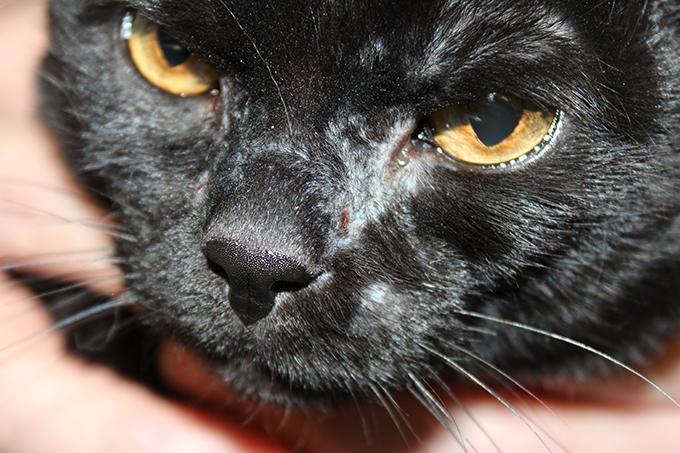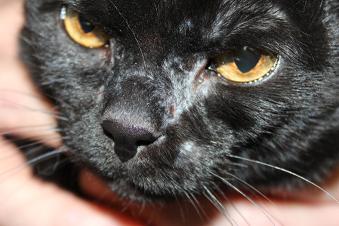-
About
- Leadership & Faculty
- News & Events
-
Academics
- Graduate
- Advanced Clinical Training
- Continuing Education
- Academic Departments
- Academic Offices
- Simulation Experiences
-
Student Life
- Offices
-
Research
-
Hospitals & Clinics
- Emergency Care
- Hospital Services
-
Community Outreach
- Volunteer
Clinical Case Challenge: Feline Hair Loss
A ten-year-old spayed female domestic shorthair cat presented to Foster Hospital’s dermatology and allergy service with a one-month history of progressive hair loss around her nose and below her eyes.

History:
A ten-year-old spayed female domestic shorthair cat presented to Foster Hospital’s dermatology and allergy service with a one-month history of progressive hair loss around her nose and below her eyes.
Furthermore, the owner did not notice any pruritus and the cat seemed otherwise healthy.
Additional medical history included previous diagnoses of feline asthma and intermittent chronic constipation, both currently being well managed with inhaled fluticasone (125 micrograms twice daily) for asthma and Miralax (1 tablespoon every 12 hours by mouth) and Cisapride (3mg every 12 hours by mouth) for constipation.
Upon dermatological examination, a multifocal, patchy, clinically noninflammatory alopecia distributed on the face (bridge of the nose, perioral, periocular) was present along with bilaterally symmetrical excoriations on each side of the muzzle and mild scaling on the face (see photo).
Questions: Examine the figure and answer the questions
1. Make a list with your differential diagnoses.
2. Elaborate your diagnostic plan according to your previous list.
In this case, folliculitis (inflammation of hair follicles) is the most likely pathogenic mechanism involved. Folliculitis is most commonly caused by an underlying infection that can be either bacterial, fungal, or parasitic in nature. Due to suspected folliculitis, the next diagnostic steps should include skin cytology, examination with Wood’s lamp, trichoscopy, and/or skin scrape to rule out infectious agents. Wood’s lamp yielded a negative result in this cat, but upon hair plucking, parasitic Demodex cati compatible microorganisms were found. A subsequent etiological diagnosis of localized facial demodicosis caused by Demodex cati (probably secondary to inhalant steroid and resultant localized immunosuppression affecting the area covered by the mask) was made.
Feline demodicosis due to Demodex cati is a parasitic skin disease often associated with concurrent disease and generalized immunosuppression1,2. Local immunosuppression due to the application of topical immunomodulatory drugs, such as inhalant glucocorticoids has been reported as a potential trigger for development of localized demodicosis in two cats1.
References
- Bizikova P. Localized demodicosis due to Demodex cati on the muzzle of two cats treated with inhalant glucocorticoids. Vet Dermatol. 2014 Jun;25(3):222-e58.
- Scott DW, Miller WH, Griffin CE. Muller & Kirk’s Small Animal Dermatology 6ed. Philadelphia: W.B. Saunders, 2001.
Department:
Foster Hospital for Small Animals
